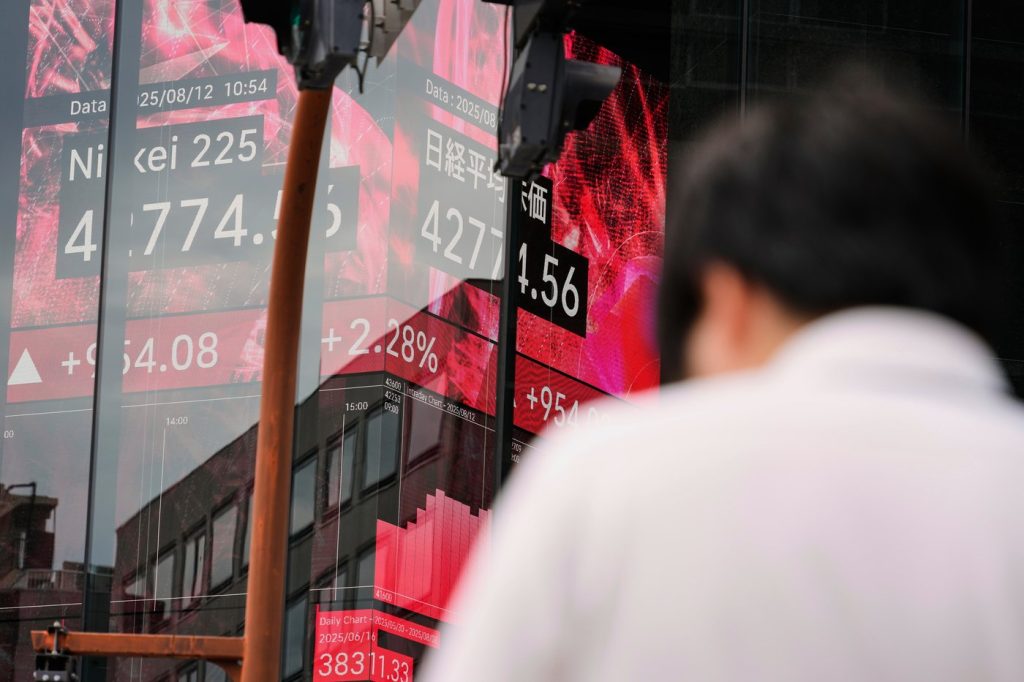TOKYO (AP) — Asian shares witnessed a predominantly positive trend on Tuesday following President Donald Trump’s announcement to delay the increase of tariffs on China for an additional 90 days. This decision has provided some relief to investors amid ongoing trade tensions between the two major economies.
Japan's benchmark Nikkei 225 saw a significant rise of 2.6%, reaching a new all-time high of 42,942.14, bolstered by substantial gains in heavyweight shares, most notably Toyota Motor Corp., whose shares surged by 3.3%.
On the other hand, Hong Kong’s Hang Seng Index experienced a slight decline of nearly 0.2%, closing at 24,865.07. Conversely, the Shanghai Composite made modest progress, increasing by 0.3% to settle at 3,658.62. Trump’s executive order issued on Monday averted a potential escalation in trade conflicts, allowing time for further negotiations on a comprehensive trade agreement. The delay was crucial as it prevented tariffs on Chinese imports from soaring from an already steep 30%.
In response to this tariff reprieve, Beijing echoed a similar sentiment with its own statement regarding the suspension of tariffs. While this extension is seen as a move that might facilitate a potential agreement, it also contributes to a prolonged period of uncertainty that businesses have faced since the commencement of the trade war by the Trump administration. Stephen Innes of SPI Asset Management remarked that the extension aims to “keep oxygen in the room for deals that matter,” emphasizing the delicate nature of the situation.
In other Asian markets, Australia's S&P/ASX 200 remained relatively stable, showing a minimal increase of less than 0.1% to 8,852.80, while South Korea’s Kospi gained 0.6%, closing at 3,227.10.
In the United States, stock markets pulled back slightly from their record highs on Monday ahead of anticipated inflation data. The S&P 500 dipped by 0.3% to 6,373.45 after nearing its previous all-time high set two weeks earlier. The Dow Jones Industrial Average fell by 0.5% to 43,975.09, and the Nasdaq composite decreased by 0.3%, ending at 21,385.40.
Wall Street's focus this week is anticipated to revolve around the inflation report due on Tuesday, which will provide insights into the rise in consumer prices for July. Economists forecast an increase of 2.8% year-over-year for essential items such as groceries and gasoline, indicating a slight uptick from June’s rate of 2.7%.
Inflation rates have remained above 2%, improving significantly from peaks of over 9% recorded three years ago. However, concerns persist that the tariffs imposed by President Trump could lead to further price escalations. This situation raises fears of a potential scenario known as “stagflation,” where economic growth stagnates while inflation continues to rise. The Federal Reserve faces a challenging situation, as it lacks an effective strategy to simultaneously address both issues, leading to potential complications when adjusting interest rates.
Michelle Bowman, a senior official at the Fed, expressed on Saturday that she believes the job market presents a larger risk. She continues to support three interest rate cuts by the Fed this year, following a surprising report regarding the U.S. job market that did not meet expectations. In contrast, Trump has vocally advocated for interest rate reductions to bolster the economy. Other Fed officials, including Chair Jerome Powell, have adopted a more cautious stance, indicating a need for more comprehensive data on the impact of Trump’s tariffs before making further decisions, with Tuesday’s consumer price index serving as a critical indicator.
Additionally, the price of gold experienced a downturn after Trump’s declaration that he would not impose tariffs on gold. Following a period of volatility in the gold market, wherein the U.S. Customs and Border Patrol suggested that certain gold bars from Switzerland could incur tariffs, the market has stabilized. Gold for December delivery settled at $3,404.70 per ounce, reflecting a decrease of 2.5%, and early Tuesday morning it registered a minor drop of 0.1% to $3,399.70.
In terms of crude oil, benchmark U.S. crude prices increased by 17 cents, reaching $64.13 per barrel, while Brent crude, the international benchmark, saw a rise of 21 cents to $66.84 per barrel. In the currency exchange markets, the U.S. dollar strengthened to 148.44 Japanese yen from 148.15 yen, and the euro was priced at $1.1621, up from $1.1618.










